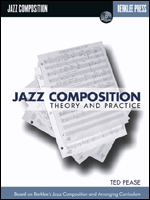Before the semester ended, a group of my undergraduate jazz students asked me to give them a list of composition assignments for the summer.
When Dave Douglas was visiting campus as a guest artist, he encouraged the students to form a composition club, where they would meet weekly to play each other's new pieces, discuss their work, challenge each other in new directions and organize public performances. Dave's guest artist fee was worth every penny as he clearly ignited the creative spark in these young, developing musicians. I wish every guest I had brought in over the years had such a positive impact.
I encouraged the students to purchase Ted Pease's text book, "Jazz Composition, Theory and Practice", published by Berklee Press. Ted taught at the Berklee College of Music for 25 years and his book is a wealth of well-organized information. I used it during the Fall 2011 semester when teaching composition as a sabbatical replacement for one of my colleagues. I did every assignment along with the students and found it to be a tremendously helpful, insightful experience which I recommend to any jazz musician with a desire to sharpen his/her composition skills.
That said, here is my list of summer jazz composition assignments, as requested by the members of UConn's new Jazz Composition Club:
Write a:
When Dave Douglas was visiting campus as a guest artist, he encouraged the students to form a composition club, where they would meet weekly to play each other's new pieces, discuss their work, challenge each other in new directions and organize public performances. Dave's guest artist fee was worth every penny as he clearly ignited the creative spark in these young, developing musicians. I wish every guest I had brought in over the years had such a positive impact.
I encouraged the students to purchase Ted Pease's text book, "Jazz Composition, Theory and Practice", published by Berklee Press. Ted taught at the Berklee College of Music for 25 years and his book is a wealth of well-organized information. I used it during the Fall 2011 semester when teaching composition as a sabbatical replacement for one of my colleagues. I did every assignment along with the students and found it to be a tremendously helpful, insightful experience which I recommend to any jazz musician with a desire to sharpen his/her composition skills.
That said, here is my list of summer jazz composition assignments, as requested by the members of UConn's new Jazz Composition Club:
Write a:
- 12-bar blues in Eb.
optional details: use an aaa (riff-type) melodic form, similar to Sonny Moon For Two. - minor blues in C.
optional details: incorporate an aab melodic form (2 identical 4-bar phrases with a different final response.) - Bird blues in F.
optional details: Write in a through-composed manner, using Charlie Parker's "Blues For Alice" as a model. - "Rhythm Changes" head in Bb.
notes: listen to many examples first, including: Anthropology, Oleo, Rhythm-a-Ning, Cottontail - new melody over the harmony of one of the following: All The Things You Are, Out of Nowhere, What Is This Thing Called Love? Green Dolphin Street.
- 32-bar AABA modal tune.
optional details: put the A sections in D phrygian mode and the bridge in Ab lydian mode. - a 32-bar ABAC tune incorporating an ostinato bass figure in the A sections. Try to capture a "spooky" quality.
- through-composed piece by starting with a brief motif (in the vicinity of 5 notes). On scrap paper, manipulate the motif using standard motivic development techniques, including repetition, sequence, inversion, retrograde, augmentation, diminution, etc. Afterwards, harmonize the melody.
- piece using unconventional notation/aleatoric/graphic score techniques to convey your ideas
- a 32-bar, medium tempo swing piece. Decide on a form. Begin by writing strong, distinguishable rhythms, later adding notes and harmony.


No comments:
Post a Comment